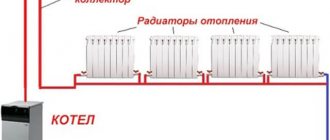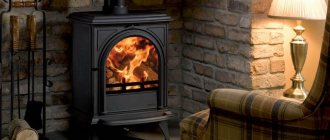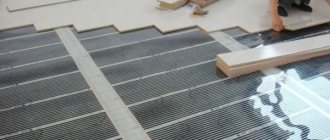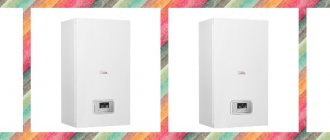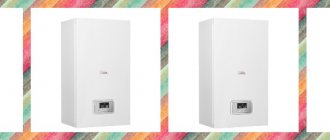Operating experience from October 2021 to April 2021.
When choosing a home heating system, there were not many options.
There is no main gas supply in our village along the Novorizhskoe highway in the Moscow region. The gas holder was excluded due to lack of space while complying with occupancy standards. Therefore, we considered two possible options for electric heating: either an electric boiler and heating radiators or heating with electric convectors with inverter control. Since any owner of a new country property, where there is no gas or its supply is very expensive, faces a similar choice, we want to share our own experience. The house is located in the Moscow region, year-round living. The house is one-story with second light, high ceilings, large windows in the living room (living room area 42 sq.m.). The total area of the house is 130 sq. m. meters. The house was built using frame technology, with a pile foundation. When building the house, special attention was paid to the quality of insulation. When using electric heating, the quality of home insulation is a key factor in saving money.
Initially, heating was planned based on an electric boiler. But I didn’t want to spoil the new interior with pipes, and the high cost of equipment and installation forced me to explore other options for electric heating. In addition, the neighbors were very puzzled by the costs of heating with an electric boiler in houses of comparable area and material - 15,000-22,000 rubles per month. not the coldest winter 19/20. Taking into account large windows and permanent residence, the prospect of investing over 300 thousand rubles in heating. and then pay 15 thousand rubles. Our family budget was not satisfied with our monthly budget.
Therefore, the choice was made in favor of heating the house using inverter-controlled convectors. In October 2021, 8 Electrolux ECH/AG2-T inverter convectors with an ECH/TUI3 control unit with power from 1 kW to 2.5 kW were installed. We survived the winter of 20/21 with this system and can share our experience of use and real calculations of energy consumption.
In this video, how to install an inverter heating system:
House plan, Moscow Region, Istra district
Electric boilers for houses up to 200 sq. m.
1
Protherm Slope RAY 18 KE /14 18 kW single-circuit
Rating:5.0
- Thermal power: 6 – 18 kW
- Mains voltage: three-phase
- Power levels: 3
- Maximum current 3F: 27.50 A
- Coolant temperature: 25 – 85 °C
- Functions: autodiagnostics, frost protection, power-on indication, overheating protection, thermometer, pressure gauge
Average price: RUB 54,292
A high-quality unit from a European manufacturer demonstrates high efficiency throughout its entire service life. The device is equipped with a durable cylindrical copper heat exchanger. The multifunctional LCD display displays the temperature of the coolant in the heating circuit and boiler, as well as information about faults. This powerful heating device uses a 380 V three-phase power supply to operate.
Peculiarities:
- intelligent connection of heating elements;
- powerful safety unit (thermal fuse, frost protection);
- an effective diagnostic system for checking the functionality of all components.
The electric boiler looks elegant; such a device can be placed in a visible place without damaging the interior.
2
Reko 24P 24 kW single-circuit
Rating:4.9
- Thermal power: 9 – 24 kW
- Mains voltage: three-phase
- Power levels: 3
- Maximum current 3F: 50 A
- Coolant temperature: 10 – 85 °C
- Functions: autodiagnostics, frost protection, heating floor connection, programmer, power-on indication, overheating protection, thermometer
Average price: RUB 36,200
A powerful 24-kilowatt boiler performs its tasks automatically with the ability to manually adjust the power. Special sensors monitor the temperature of the water in the circuit and the environment. It is permissible to use antifreeze intended for household heating systems as a coolant. The pressure in the main circuit should not exceed 2.5 bar. A simple control panel and LED display make it easy to monitor the operation of the device.
Peculiarities:
- the ability to program temperature by day of the week;
- built-in electricity consumption meter;
- Manufacturer's warranty on the heat exchanger is 8 years.
Despite its impressive power, the boiler is small in size. In maximum power mode, this unit can be used to maintain a comfortable microclimate in a room up to 240 sq. m.
3
EVAN Warmos-IV-21 21 kW single-circuit
Rating:4.8
- Thermal power: 7 – 21 kW
- Mains voltage: three-phase
- Power levels: 3
- Maximum current 3F: 50 A
- Coolant temperature: 5 – 85 °C
- Functions: autodiagnostics, heating floor connection, power-on indication, overheat protection, thermometer
Average price: RUB 33,130
A powerful electric boiler for the home is capable of operating in an extended coolant temperature range of +5℃…+85℃. The total power of the heating elements of this boiler is 21,000 W. The set temperature value is maintained by automatic selection of power levels. Operating status data and fault error codes are shown on the display. The unit can be successfully combined with a “warm floor” system, subject to the installation of shut-off and control valves.
Peculiarities:
- increased safety due to an emergency shutdown system;
- durable stainless steel heating elements with rotation when turned on.
The unit operates stably and does not require complex maintenance. Users have no complaints about its reliability and durability.
Video: How to choose a good electric heating boiler
Complete set of inverter heating system
Since Electrolux has many different models, the exact article number of the convectors installed in the house is: ECH/AG2-1000T – TUI3. Where the letter "T" indicates that this is the Transformer series.
The “transformer” series means that the convector consists of two main devices - the heating module itself and the control unit. They are often sold as a set. AG2 is an Air Gate heating module (if it has the letter R, then this is a Rapid model with a different design). 1000 is an indicator of the maximum power of the heating element. Inverter control unit TUI3 – (I – inverter, 3 – third generation of control units).
The power of the convectors was selected at the rate of 1 kW for an area of up to 15 sq.m. Taking into account the configuration of the house, we got 8 convectors:
- 1kW – 1 piece;
- 1.5 kW – 4 pcs.;
- 2 kW – 1 piece;
- 2.5 kW - 2 pcs.
Each convector is equipped with a digital inverter TUI 3.0 control unit and a wi-fi module.
In total, the entire set (8 heating modules, 8 digital inverter (TUI3) control units and 8 wifi modules) cost about 80,000 rubles.
Operating principle
Models powered by electricity transmit energy using heating elements, which require both a separate area for heating the coolant and protection of the heating element from corrosion. At the same time, the operating principle of inverter boilers is based on the phenomenon of electromagnetic induction.
Direct current from the network is converted into alternating current. The resulting magnetic field generates an induced current. And the device that allows all this to happen is precisely an inverter, capable of operating both from the network and from a battery (only for low-power models).
Boiler design
An inverter boiler consists of two main parts: a magnetic circuit and a heat exchanger. The circuit's tasks include creating an alternating magnetic field.
A heat exchanger is needed to transfer energy from the induction current to the coolant, increasing the temperature of the latter to the level necessary for effective heating.
Installation of inverter convectors
Installation of convectors is very simple - screw two self-tapping screws into the wall according to the supplied template; the kit includes a bracket that clings to the convector and hangs on the self-tapping screws. I did electrical wiring throughout the house at the same time, including sockets for convectors. There are no special requirements - you just need to provide separate lines for each convector.
A similar set of equipment using an electric boiler and 8 heating radiators would cost 150-160 thousand rubles. This is the first plus in favor of the heating system using Electrolux inverter convectors.
Electricity costs
Now in terms of costs, single-tariff electric meter: 4.01 rubles per kWh. Here are all the records on energy consumption during the 20/21 heating season.
This is the second and biggest advantage compared to an electric boiler: winter 20/21 was the frostiest in recent years. The maximum electricity consumption for heating occurred in January: 2333 kWh, which is 9 thousand rubles for permanent residence. I compare it with the costs of neighbors in the village - with approximately the same houses, the cost of heating with an electric boiler was 15,000-18,000 rubles per month. Moreover, unlike us, who live permanently in a house and with a temperature of 21 degrees, neighbors sometimes visit when they are not there - the electric boiler was working at a minimum power.
The third plus in favor of the inverter system: there are no pipes and, for my taste, the design of the convector is much nicer than a boring panel radiator.
Control
What is convenient about an inverter convector? You set the desired temperature and then the convector independently monitors the current temperature and smoothly changes the heating power. Unlike conventional convectors, which operate in on/off mode, an inverter-controlled convector smoothly changes heating power depending on the difference between the current and set temperature.
You can control your heating remotely via the Hommyn mobile app. In the mobile application, convectors can be combined into groups (for example, three convectors can be combined into a “living room” group), and the group can be managed as a single device. To control via a mobile application, a wifi network is needed in the house.
The display of the control unit goes out a few seconds after setting or changing operating parameters: at night the display does not irritate with a bright glow. Convenient darkened lid to prevent accidental button presses.
Design and operating principle
The functioning of boilers varies depending on the type of equipment. But the basic principle of operation is to heat water to the required temperature by converting electrical energy into heat.
The design of the devices, depending on the model, includes the following components:
- circulation pump;
- expansion tank;
- sensors monitoring overheating and water pressure;
- air vent, safety valve;
- display;
- programmer;
- remote control;
- heating block;
- thermostat;
- pressure gauge;
- thermometer.
Manufacturers may change equipment configurations. Therefore, when purchasing a device, you must read the accompanying documentation.
Comparison of an inverter system with heating using an electric boiler
What conclusion can be drawn after six months of operation:
- The heating system based on Electrolux inverter convectors is a complete home heating system. It can automatically regulate the temperature and is convenient to control, including remotely.
- The inverter system is much cheaper in terms of equipment and installation costs.
- The inverter system is much more economical. According to research by the Moscow Energy Institute, such savings reach 40%. This is explained by the high inertia of the heating system according to the “boiler-radiator” scheme while maintaining a given temperature.
- System reliability. If one element of the inverter system breaks down, the house will not freeze, which cannot be said about the heating system on the boiler. If the boiler or pump fails, the entire heating system of the house will stop working. And it is not always possible to quickly solve a problem without the help of a specialist.
- Aesthetics: no white polypropylene pipes on the walls, space saving - no boiler room needed.
In the video below: Research by the Moscow Energy Institute comparing the energy consumption of a heating system using electric convectors with inverter control and a heating system “electric boiler + water radiators”.

